Atrium art in Bessey
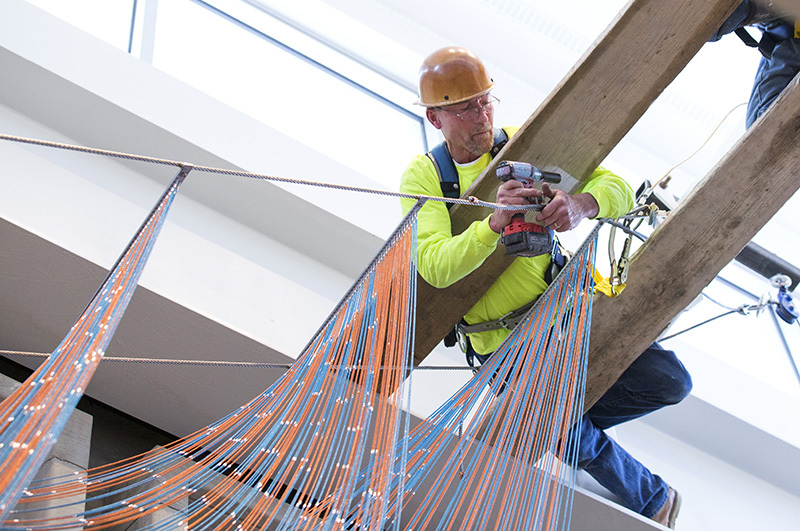
Pat Webb of U.S. Erectors works to install the "Y in the Road" sculpture in the Bessey Hall atrium on Tuesday. Photos by Christopher Gannon.
Bessey Hall, home to bioscience offices, labs and greenhouses, also is home to Iowa State's newest public artwork. The sculpture, with a working title ("Y in the Road") that is likely to change, features 6.5 miles of colorful, stainless steel ball chains suspended in the four-story atrium linking the addition to the original building. Designed and fabricated by Ball-Nogues Studio, Los Angeles, artists Benjamin Ball and Gaston Nogues embraced the biosciences with a conceptual representation of a phylogenetic tree -- a branching diagram that shows evolutionary relationships among species.
The sculpture is part of the Iowa Art in State Buildings program, which designates 0.5 percent of new construction and remodeling funds for public art. The 2017 Legislature repealed this requirement, but projects underway were grandfathered in.
Ball-Nogues Studio produced two sculptures for Iowa State's $88 million combined biosciences facilities project -- one installed this week in the four-story Bessey addition ($265,000) and another for the newly constructed Advanced Teaching and Research Building ($135,000). The ATRB artwork will be installed later this spring.
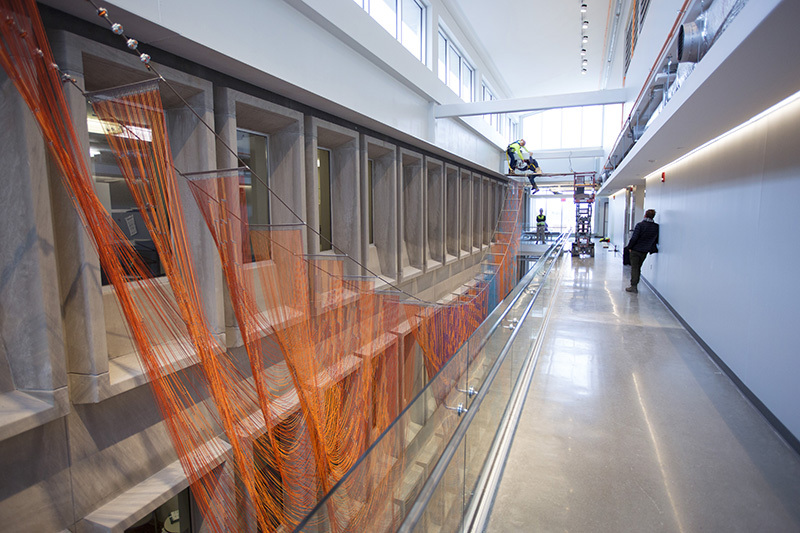
Get a feel for Okta as an early adopter
Learn more about WorkCyte
Faculty, staff and students who want to take Okta on a test drive can start using the identity and access security platform on a volunteer basis. That means just one password to remember for access to multiple web-based programs and applications, such as Outlook 365 and Cybox.
"Okta will make our day-to-day duties more convenient and help keep us safe by protecting individual and university information," said Mike Lohrbach, director of enterprise services and customer success for information technology services. "It will streamline some of the password reset and account unlock capabilities we have at Iowa State."
Users can customize their Okta dashboards with access to their most-used applications. All ISU's web-based applications will be part of the early Okta enrollment experience. Programs installed on computers are not included.
"Anything that you authenticate through the web with your Iowa State credentials -- those are our scope," Lohrbach said.
Give it a whirl
Okta participants can use their Net-ID and password to log in to Okta via a web browser, such as Firefox, Chrome or Safari. Once users are signed in, applications enrolled in Okta are available without another login. Lohrbach said Okta allows users a 10-hour session with a single, secure login from anywhere.
"Early enrollment is going to help people get logged in and become familiar with Okta and how it will streamline the way they access university applications," Lohrbach said.
Lohrbach said ISU's current sign-ons page available through a link from the homepage is a good example of what Okta's dashboard experience will provide.
"That's almost like a mini university-wide dashboard," he said. "The most common things are there -- I click, log in and go to the app."
The WorkCyte timeline projects campuswide Okta enrollment by the end of the semester.
Secure login
Okta will require multifactor authentication (MFA) for logins, adding another layer of security. MFA provides one-time authentication codes during the login process, available five ways:
- Okta Verify mobile application
- Text message
- Phone call
- Google Authenticator
- Physical "token" (YubiKey, similar to a USB jump drive), carried by the user
"We encourage people to enroll in as many [factors] as they can," he said. "If they forget their phone and can't get an authentication code via text or phone call, they have other options. You can pick from a drop-down menu which factor you want to use."
Spring enrollment is third highest on record
There are 33,345 students enrolled at Iowa State this spring, 763 fewer than the record-setting spring semester 2017 and 314 fewer than spring 2016. The spring student count was taken on Jan. 22.
Undergraduate enrollment is down 678 students and graduate enrollment is down 106 students from a year ago. There are 14 more post doctoral researchers on campus this spring than a year ago. These specific student populations also are larger this spring than last:
- Business undergraduate students, up 2.3 percent (100 students)
- Engineering graduate students, up 3.4 percent (45 students)
- Design graduate students, up 20.5 percent (32 students)
Iowa State had a record number of December graduates last month, 2,349. Fall graduations are a key variable in the difference between fall and spring enrollments. Last September, Iowa State enrolled 36,321 students.
Spring enrollment by college
|
College |
2018 |
2017 |
|
Agriculture and Life Sciences |
4,952 |
5,065 |
|
Business |
4,733 |
4,662 |
|
Design |
1,932 |
1,936 |
|
Engineering |
8,661 |
8,658 |
|
Human Sciences |
4,420 |
4,667 |
|
Liberal Arts and Sciences |
7,279 |
7,688 |
|
Veterinary Medicine |
747 |
745 |
|
Graduate interdisciplinary |
302 |
382 |
|
Subtotal |
33,026 |
33,803 |
|
Post docs |
319 |
305 |
|
Total |
33,345 |
34,108 |
Vet Med dean finalists will visit campus next month
Four finalists have been selected in the College of Veterinary Medicine dean search and will interview on campus in February. Each candidate's name and application materials will be shared publicly the day before his or her visit. Visit dates are: Feb. 1-2, Feb. 6-7, Feb. 12-13 and Feb. 19-20.
Candidates will meet with students, faculty and staff, and each will hold an open forum on the first day of the visit. The one-hour forums will begin at 3:15 p.m. in 2532 Vet Med.
The open forums will be recorded and made available online after all campus visits have concluded for those unable to attend in person. An online feedback form will be available on the provost's office search website.
What drives campus commuters who bike, even in winter
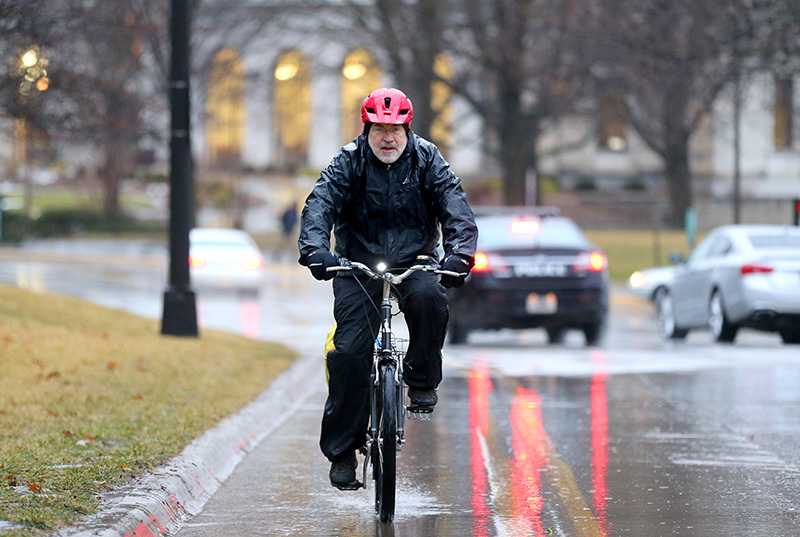
Thomas Brumm, the Mary and Charles Sukup Global Professor in Food Security, commutes to campus by bicycle all year, even in the winter. Photo by Christopher Gannon.
Bob Horton has a stock answer for incredulous inquiries about his year-round bicycling, which includes daily rides to work.
"I'm not that smart," the Distinguished Professor of agronomy jokingly tells people.
Commuting to campus on two wheels no matter the calendar isn't common. Bike racks bustling in the spring, summer and fall get pretty lonely in the winter. But all-year biking is possible for robust spirits with plentiful motivation.
Here's what drives three faculty members to pedal to work in all seasons, even in the depths of winter.
Winter biking tips
- Daylight gets short in the winter. Make sure your bike has lights.
- Take it slow, especially on turns and hills.
- As you would any season, assume pedestrians, fellow bikers and drivers don't see you.
- Layers and face masks help cut the cold.
- Consider wider or studded tires.
- Any time of year: Always wear a helmet, no exceptions.
Serving as a model
Thomas Brumm, the Mary and Charles Sukup Global Professor in Food Security, came to campus on something other than a bike seat just three times in 2017. There are many reasons he's so committed.
"You could say I'm trying to save the planet and conserve resources. You could say I want to get exercise and keep physically fit. But the primary reason, really, is I'm cheap. I can buy a bicycle for one car payment," said Brumm, associate professor in agricultural and biosystems engineering and associate director of the Center for Sustainable Rural Livelihoods.
Beyond the savings, Brumm thinks it's good for his teenage sons and his students to see an "old guy" who bikes. "In general, people can do more physically than they think they can," he said.
Living close to campus, six blocks south of the Memorial Union, makes his daily riding routine take just as long as it would to drive in, he said. Getting around campus is easier during the day, with most destinations a five-minute ride away.
Biking practically every winter day, Brumm encounters both slippery roads and face-numbing cold. The key to handling icy streets is keeping inertia in mind: slow down in general, almost to a crawl when turning. Proper gear makes the cold bearable, he said. His getup on the most frigid mornings includes a face mask, eye protection, lobster gloves, wind pants and, of course, a hat, coat and helmet. Only his nose is exposed.
"On really, really cold days, about the time I think I can't take it anymore, I'm here," he said.
One upside in the winter is he never struggles to find a spot in the bike rack outside Elings Hall, unless it's buried in a snow drift.
Meant to be
Horton came to winter biking gradually and by coincidence. He lives west of campus, a 25-minute stroll to his office in good weather. The observant Catholic always liked walking to work, using that time to pray. He kind of misses walking, actually. The alertness biking requires makes it less meditative, he said.
But about 10 years ago, a homeless man staying at a shelter where Horton met two bikers for a weekly prayer breakfast found out Horton didn't own a bicycle. The homeless man had two bikes and offered Horton one. He was insistent.
"I tried it, and I found some advantages," Horton said, meaning mainly speed. It cuts his commute to about 10 minutes, if he times his trip to Agronomy Hall to avoid class-change periods.
At first, he put his bike away after autumn. But a few years ago, in a stretch of especially mild winters, he started riding year-round. Then the frame broke on his first gifted bike just as a neighbor, unaware his current ride was done for, offered to give him yet another bicycle.
"It's like I'm supposed to be biking," he said.
Horton has kept with winter biking ever since, a slow and cautious rider who avoids slopes and will leave his bike home if the roads are slick. He doesn't use any special equipment in the winter, other than a stocking cap under his helmet. A face mask fogs up his glasses. "I keep my head warm and just endure it," he said.
Though Horton never goes on long road rides, he'd rather use a bike to get pretty much anywhere in town. Sometimes, he'll even bike separately and meet his family at the restaurant when they go out to eat.
Seeing what's missed
Ray Arritt, an agronomy professor, doesn't understand why some bicyclists listen to music while they're on a ride. "To me, that just spoils the whole reason for doing it," he said.
While the built-in exercise component of everyday bike commuting has become more important to the climate researcher as he's gotten older, prompting him to more deliberately stick to a year-round schedule, it also is an opportunity to ponder and observe.
"Like any form of exercise, it gives you some space to think. You're out there alone," he said. "You see things that are interesting. You see wildlife. You see flowers. You just notice so many things that you wouldn't notice otherwise."
Arritt rides to campus from his home in north Ames, about 3 miles away. It takes 15 minutes unless he extends his journey by taking trails. He'll forgo his bike if streets are covered with ice or snow, but cold is rarely an issue. With a heavy coat, scarf and a face mask, he can handle most temperatures, though he wonders if it's worth it when it gets sub-zero.
"I start to question my wisdom on those days," he said.
Like Horton and Brumm, he considers biking more convenient and pleasant than driving, a time-saver with significant personal benefits.
"To me, it's just a win-win-win situation," Arritt said.
Eyes on March
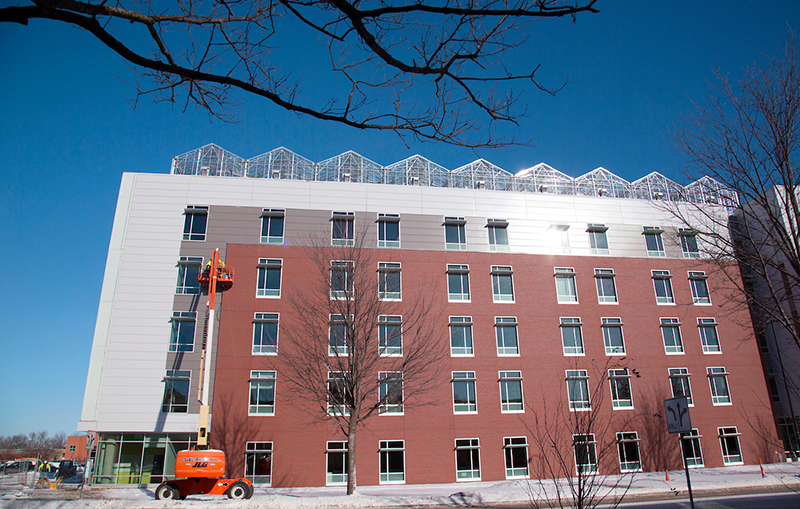
Photo by Christopher Gannon.
With the goal of moving in the first faculty members by mid-March, work is underway to install furniture and information technology at the Advanced Teaching and Research Building (ATRB). The building will be the new home of the plant pathology and microbiology department. It will house some of the faculty and graduate students from two other departments: entomology and genetics, development and cell biology.
ATRB also contains research labs, teaching labs, formal and informal collaboration spaces, and a 120-seat lecture hall that will join the university's general classroom inventory. And that's just the first four floors. Earlier this month, the unfinished top floor received state Board of Regents approval to become the home of the Iowa State-based Nanovaccine Institute. Design planning has begun, with fifth-floor occupancy targeted for fall 2019.
ATRB and the Bessey Hall addition are the two pieces of a multiyear effort to update Iowa State's biosciences facilities. Funding for the $88 million project came from state appropriations, university funds, private gifts and facilities bonds.
Green Dot exhibit encourages action

While the Green Dot violence prevention program is fairly new to the Iowa State campus, program organizers hope an exhibition at the reACT Gallery in Morrill Hall through Feb. 16 will help faculty, staff and students take a stand against violence.
The free exhibition, open Monday through Friday, 11 a.m. to 4 p.m., features 12 sculptures and paintings from University Museums' permanent collection. The artwork is meant to start conversations among visitors about what they can do to prevent or stop violent situations and what barriers hold back bystanders from helping others.
Within the exhibit
The exhibit encourages action. Visitors may write notes on green stickers and affix them to walls or pedestals near the artwork to help others view the pieces from different perspectives. At the back of the gallery, individuals can write down ways they plan to prevent violence, even if it's just talking to friends about the Green Dot program. A video that portrays victims of sexual assault and harassment plays near a display about the #MeToo movement.
"There's a current movement of art therapy as a way to support survivors of power-based violence," said Jazzmine Brooks, violence prevention and Green Dot coordinator in student wellness. "Using art is a way to silently engage in the resources available on campus and to continue conversations about how to prevent violence."
Outside the exhibit
Several campus activities are planned in conjunction with the Green Dot exhibition.
- Social media challenge, through Jan. 28: Post "What's Your Green Dot?" on Facebook or Instagram using #ISUGreenDot. A "green dot" can be as simple as talking with friends about not tolerating violence or wearing Green Dot program gear.
- "The Hunting Ground" documentary, Jan. 25 (5:30-7:30 p.m., 2019 Morrill): This film follows the stories of two sexual assault survivors.
- Pop-up exhibition, "Small Acts, Big Impacts," Feb. 1 (11 a.m.-1 p.m., lobby and 405 Parks Library): Participate in trivia and learn what Iowa State has done in the past to positively impact change on campus. Trivia answers will be available at reACT Gallery.
-
Green Dot dining, Feb. 4-9: Visit the dining centers and enjoy a free Green Dot cookie.
- Sunday, Feb. 4: Conversations
- Monday, Feb. 5: Storms
- Tuesday, Feb. 6: Union Drive Marketplace
- Wednesday, Feb 7: Friley Windows
- Friday, Feb. 9: Seasons Marketplace
- Green Dot podcasts, "Redefining Relationships," Feb. 12-16: Learn about healthy relationship behaviors, dispel myths and hear from experts and students about how to navigate common relationship issues. View on the ISUGreenDot Facebook page.
Brooks hopes the exhibit and its related events will ignite conversations about how individuals can help prevent violence at Iowa State.
"My goal is for people to understand the program and see their role in it," she said. "If people know what their role is, they can begin to speak up."
A trip to 'Oz'
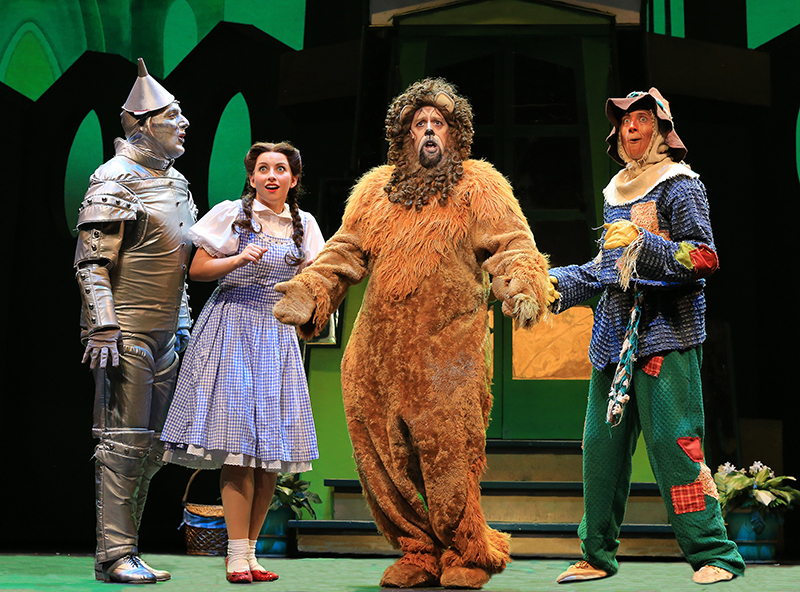
Contributed photo.
Enjoy dinner and a show at the Iowa State Center when "The Wizard of Oz" touches down at Stephens Auditorium on Tuesday, Jan. 30.
The show includes Oscar-winning music and new songs in an adapted production that celebrates the beloved characters and storyline of the 1939 classic film. "The Wizard of Oz" boasts vibrantly colorful sets and special effects as Dorothy and her friends -- the lion, scarecrow and tin man -- trek through the magical land of Oz in search of the wizard.
Tickets for the 7:30 p.m. show are $42-$78, available through Ticketmaster (800-745-3000) and at the Stephens ticket office. An optional 6 p.m. preshow dinner in the Scheman Building features four Oz-themed courses for $32. Dinner reservations must be purchased in advance by phone (294-2479), with a limited number of spots available.
